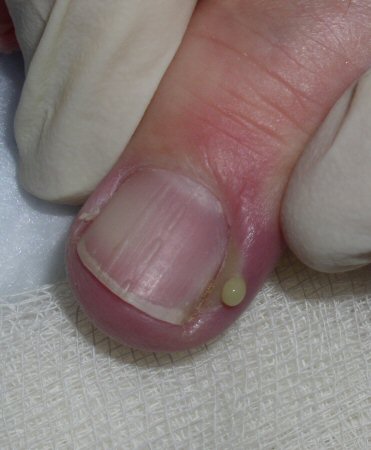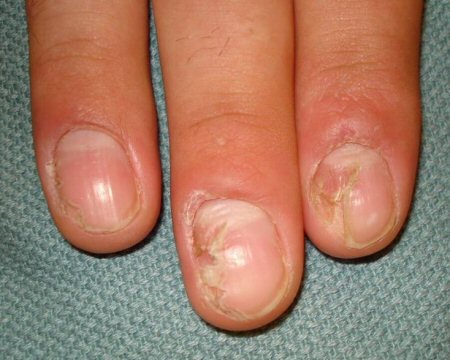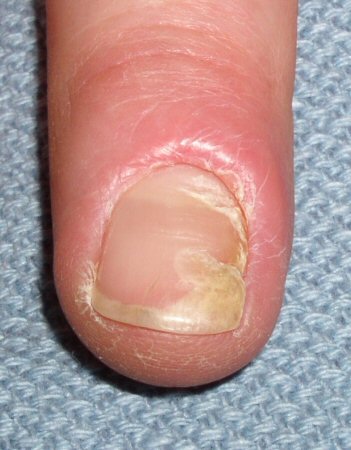History and exam
Key diagnostic factors
common
presence of risk factors
Key risk factors include microscopic or macroscopic injury to the nail folds and cuticle, adults exposed to occupational contactants or cosmetics or certain medications, female sex, and toddlers who suck their fingers.
pain, swelling, drainage (acute)
Common complaint in acute paronychia.[Figure caption and citation for the preceding image starts]: Acute paronychiaFrom the collection of Dr N.J. Jellinek and Professor C.R. Daniel III [Citation ends]. [Figure caption and citation for the preceding image starts]: Acute paronychia: draining pusFrom the collection of Dr N.J. Jellinek and Professor C.R. Daniel III [Citation ends].
[Figure caption and citation for the preceding image starts]: Acute paronychia: draining pusFrom the collection of Dr N.J. Jellinek and Professor C.R. Daniel III [Citation ends].
swollen, purulent nail fold (acute)
Characteristic of acute paronychia on exam.[Figure caption and citation for the preceding image starts]: Acute paronychia: draining pusFrom the collection of Dr N.J. Jellinek and Professor C.R. Daniel III [Citation ends].
nail plate irregularities (chronic)
Common complaint in chronic paronychia.[Figure caption and citation for the preceding image starts]: Chronic paronychiaFrom the collection of Dr N.J. Jellinek and Professor C.R. Daniel III [Citation ends]. [Figure caption and citation for the preceding image starts]: Chronic paronychiaFrom the collection of Dr N.J. Jellinek and Professor C.R. Daniel III [Citation ends].
[Figure caption and citation for the preceding image starts]: Chronic paronychiaFrom the collection of Dr N.J. Jellinek and Professor C.R. Daniel III [Citation ends].
swelling/redness of nail folds (chronic)
Common complaint in chronic paronychia.
pink, swollen nail folds (chronic)
Characteristic of chronic paronychia on exam.
missing cuticle (chronic)
Characteristic of chronic paronychia on exam.
underlying nail plate abnormalities (chronic)
Characteristic of chronic paronychia on exam.
Risk factors
strong
microscopic or macroscopic injury to the nail folds (acute)
This is the only portal of entry for microbes into the periungual tissues.
occupational risks (acute and chronic)
Work-related trauma to the nail folds creates the portal of entry and causes disruption in the nail barrier due to exposure to irritants.
barrier damage to the nail folds, cuticle (chronic)
The normal barrier is impermeable to microbes, moisture, and irritants. Any manipulation or loss of this barrier exposes the normally protected tissue under the proximal nail fold to persistent and cumulative moisture, microbe, irritant, and occasional allergic contactants. This cycle of inflammation persists until the insults are removed and the normal nail barrier is reformed.
ingrown nail
weak
toddler and adult
All ages can be affected, but peak incidence is in toddlers (finger suckers) and adults.
female
Women are more likely to be affected than men.
Use of this content is subject to our disclaimer